

List of free and open source software packages. The Great Gatsby - For Nes. Open-source robotics. Main Page. Flowplayer - Flash Video Player for the Web. Free-net. A free-net was originally a computer system or network that provided public access to digital resources and community information, including personal communications, through modem dialup via the public switched telephone network.

The concept originated in the health sciences to provide online help for medical patients. With the development of the Internet free-net systems became the first to offer limited Internet access to the general public to support the non-profit community work. The Cleveland Free-Net (cleveland.freenet.edu), founded in 1986, was the pioneering community network of this kind in the world.[1] The word mark Free-Net was a registered trademark of the National Public Telecomputing Network (NPTN), founded in 1989 by Tom Grundner at Case Western Reserve University. The Internet domain name freenet.org was first registered by the Greater Detroit Free-Net (detroit.freenet.org), a non-profit community system in Detroit, Mi, and a member of the NPTN. AFGROW. AFGROW (Air Force Grow) is a Damage Tolerance Analysis (DTA) framework that allows users to analyze crack initiation, fatigue crack growth, and fracture to predict the life of metallic structures.
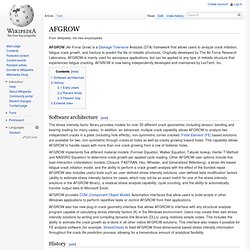
Originally developed by The Air Force Research Laboratory, AFGROW is mainly used for aerospace applications, but can be applied to any type of metallic structure that experiences fatigue cracking. AFGROW is now being independently developed and maintained by LexTech, Inc. Software architecture[edit] The stress intensity factor library provides models for over 30 different crack geometries (including tension, bending and bearing loading for many cases). In addition, an advanced, multiple crack capability allows AFGROW to analyze two independent cracks in a plate (including hole effects), non-symmetric corner cracked.
Thunar. List of free and open source software packages. Open-source software. Uzebox. Features[edit] Uzebox prototype connected to a TV and showing a game Hardware Specifications[edit] Uzebox AVCore's board described CPU: ATmega644 microcontrollerTotal RAM: 4KProgram Memory: 64KSpeed: 28.61818 MHz (Overclocked)Colors: 256 simultaneous colors arranged in a 3:3:2 color space (Red:3 bits, Green:3 bits, Blue: 2 bits)Video output: NTSC Composite and S-VideoSound: 8-bit mono, mixed at ~15 kHz and output via PWMInputs: Two NES/SNES compatible joypad inputsExternal storage: SD/MicroSDOptions: MIDI-in interface Implementations[edit] Since its inception, the Uzebox design has been commercially implemented as the Fuzebox Do-It-Yourself kit[2] and the Uzebox AVCore, a fully assembled unit.
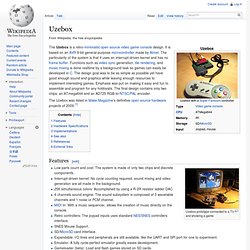
Free Beer. An unopened bottle of Free Beer (version 3.2, brewed by the St Austell Brewery) with a label in English.
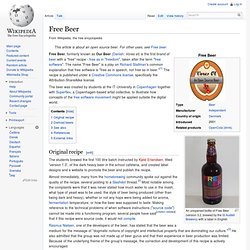
Open-source hardware. Open source hardware consists of physical artifacts of technology designed and offered by the open design movement.

Both free and open source software (FOSS) as well as open source hardware is created by this open source culture movement and applies a like concept to a variety of components. The term usually means that information about the hardware is easily discerned. Hardware design (i.e. mechanical drawings, schematics, bills of material, PCB layout data, HDL source code and integrated circuit layout data), in addition to the software that drives the hardware, are all released with the FOSS approach. Since the rise of reconfigurable programmable logic devices, sharing of logic designs has been a form of open source hardware.
Instead of the schematics, hardware description language (HDL) code is shared. Open source. Linux Based Devices. Bitcoin P2P Virtual Currency. VLC media player. VLC media player supports many audio and video compression methods and file formats, including DVD-Video, video CD and streaming protocols. It is able to stream over computer network and to transcode multimedia files.[7] The default distribution of VLC includes a large number of free decoding and encoding libraries, avoiding the need for finding/calibrating proprietary plugins. Many of VLC's codecs are provided by the libavcodec library from the FFmpeg project, but it uses mainly its own muxer and demuxers and its own protocols implementations.
It also gained distinction as the first player to support playback of encrypted DVDs on Linux and OS X by using the libdvdcss DVD decryption library. History[edit] The VideoLan project was originally started as an academic project in 1996. It was intended to consist of a client and server to stream videos across a campus network. In 2011 and 2012, large parts of VLC were relicensed to the GNU Lesser General Public License.[16][17] OpenCores. Vorbis. Vorbis is a continuation of audio compression development started in 1993 by Chris Montgomery.[9][10] Intensive development began following a September 1998 letter from the Fraunhofer Society announcing plans to charge licensing fees for the MP3 audio format.[11][12] Vorbis project started as part of the Xiphophorus company's Ogg project (also known as OggSquish multimedia project).[13][14] Chris Montgomery began work on the project and was assisted by a growing number of other developers. They continued refining the source code until the Vorbis file format was frozen for 1.0 in May 2000[1][2][15] and a stable version (1.0) of the reference software was released on July 19, 2002.[16][17][18] Name[edit] "Vorbis" is named after a Discworld character, Exquisitor Vorbis in Small Gods by Terry Pratchett.[10] The Ogg format, however, is not named after Nanny Ogg, another Discworld character; the name is in fact derived from ogging, jargon that arose in the computer game Netrek.[10]
Free Lossless Audio Codec. FLAC (/ˈflæk/; Free Lossless Audio Codec) is a codec for lossless compression of digital audio.
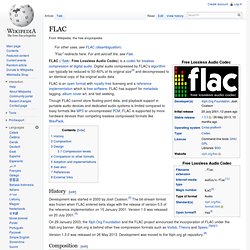
Digital audio compressed by FLAC's algorithm can typically be reduced to 50–60% of its original size[4] and decompressed to an identical copy of the original audio data. FLAC is an open format with royalty-free licensing and a reference implementation which is free software. FLAC has support for metadata tagging, album cover art, and fast seeking. Though FLAC cannot store floating-point data, and playback support in portable audio devices and dedicated audio systems is limited compared to lossy formats like MP3 or uncompressed PCM, FLAC is supported by more hardware devices than competing lossless compressed formats like WavPack.
History[edit] Development was started in 2000 by Josh Coalson.[5] The bit-stream format was frozen when FLAC entered beta stage with the release of version 0.5 of the reference implementation on 15 January 2001. Version 1.3.0 was released on 26 May 2013. ANts P2P. Download. Download License & Disclaimer Alchemy is free software: you can redistribute it and/or modify it under the terms of the GNU General Public License as published by the Free Software Foundation, either version 3 of the License, or (at your option) any later version.
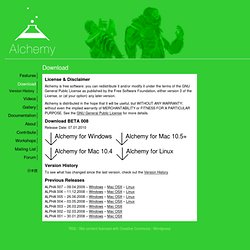
Alchemy is distributed in the hope that it will be useful, but WITHOUT ANY WARRANTY; without even the implied warranty of MERCHANTABILITY or FITNESS FOR A PARTICULAR PURPOSE. See the GNU General Public License for more details. Download BETA 008 Release Date: 07.01.2010.